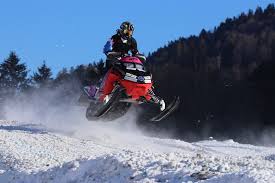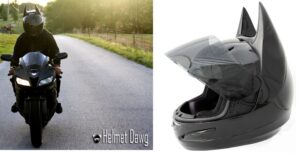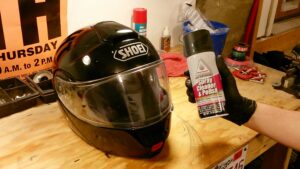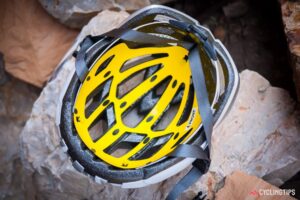If you’re looking for a way to cross the ice, whether for transport or pleasure, the snowmobile is the way to go. Today’s article will cover the basics of snowmobiles – what they are and how does snowmobile work.
Contents
- What is a Snowmobile?
- When was the Snowmobile invented?
- How does Snowmobile work?
- Main parts of a Snowmobile
- How to steer a snowmobile?
- More interesting features of snowmobiles
- Environmental concerns
- Top 6 batman helmet for motorcycle
- How to clean motorcycle helmet?
- Baby Helmet For Flat Head: Should You Use A Helmet To Correct Your Baby’s Head Shape?
- What is MIPS Helmet? Is It Worth Buying?
- 5 Fashionable Bike Helmet To Buy Right Now
- Top 6 Most Suitable Women’s Ski Helmet in 2022
- 20 Best Helmets For Paintball To Play Sports
- Top 5 Most Stylish Women’s Dirt Bike Helmet
What is a Snowmobile?
A motor-driven vehicle designed to travel over snow and ice is referred to as a snowmobile, also known as a Ski-Doos. The sIn regions with chilly, snowy winters, snowmobiles are utilized for both transportation and travel, as well as for winter entertainment. Snowmobile recreation, which was first developed as a utilitarian vehicle, has increased in popularity to encompass pursuits like sightseeing, trail riding, winter fishing, and hunting. racing, freestyle, and shooting. Snowmobiles feature a handlebar, saddle, and frame. Riders cross their legs in the seat and use the handlebars to steer the vehicle like they are on a motorbike. The majority of snowmobiles are driven by a rail in the back and have two skis up front.
When was the Snowmobile invented?
Early 1900s innovators employed rail-powered vehicles to go through snowy and ice terrain; this is where the current snowmobile got its start. A vehicle with a rear-wheel and a front skid was patented by Ray H. Muscott in 1915–1916 in both Canada and the US. Ford Model Ts are frequently modified using this concept to make them snow-ready. “Snowflyers” is the name given to these customized vehicles.
A snowmobile converter for the Model T was designed by Virgil D. White and marketed directly via Ford dealers between 1917 and 1918. The first contemporary snowmobile with a permanent skid board and a rear track was developed in 1935 by Joseph Bombardier, the company’s founder. Many of the original snowmobiles were built with the capacity to transport numerous people over ice. Bombardier improved their concept by 1959 and unveiled the Ski-Doo, the first contemporary snowmobile to achieve commercial success. As the open-like motorcycle seat style gained popularity, the number of snowmobile manufacturers increased to over 100 by the 1970s.
How does Snowmobile work?
Most snowmobiles are powered by 2-stroke or 4-stroke internal combustion engines. Snowmobiles work with a combination of 4 main parts, including:
- The engine.
- The clutch mechanism.
- The track band.
- The skis.
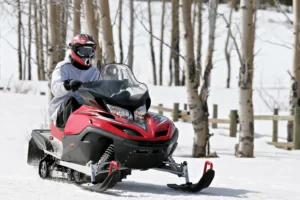
Main parts of a Snowmobile
The engine, clutch, wheels, and skis are the major components of a snowmobile that allow it to function. In addition, many of the components are the same as those found in motorcycles, dirt bikes, or ATVs. We will go through each of the crucial elements that make the sled function in more detail below.
Snowmobile engine
A snowmobile’s engine is comparable to a motorbike or ATV’s. There are 2-stroke and 4-stroke engines available for snowmobiles, respectively. Even electric motors may be found in more recent snowmobiles. In order to deliver power to the final drive, the engine cooperates with the carburetor or fuel injectors to pull the fuel/air combination into the combustion chamber, compress it, ignite it, and repeat the process.
The clutch mechanism
A continuously variable transmission, or CVT, is the clutch mechanism used in snowmobiles. A chain or belt connects the primary and secondary clutches in this sort of gearbox. The crawler actuator is connected to the secondary clutch, which is turned by the chain or belt and rotates with the help of the crankshaft.
The main clutch engages and starts to rotate as the crankshaft turns and the RPM rises. The primary clutch is immobile in idle mode. The sprocket drive unit, which is intended to operate the gears responsible for rear gear movement, is connected to the secondary clutch. The clutch engages and disengages as necessary at higher engine speeds and RPMs to deliver the correct torque and power to the final drive. When necessary, the sled is powered by centrifugal force, cams, and driving gears.
The main clutch engages and starts to rotate as the crankshaft turns and the RPM rises. The primary clutch is immobile in idle mode. The sprocket drive unit, which is intended to operate the gears responsible for rear gear movement, is connected to the secondary clutch. The clutch engages and disengages as necessary at higher engine speeds and RPMs to deliver the correct torque and power to the final drive. When necessary, the sled is powered by centrifugal force, cams, and driving gears.
Snowmobile Track
Tracks on snowmobiles are often composed of rubber and strengthened with Kevlar or carbon fiber. They are a continuous loop with traction, studs, and ledges to grasp the snow and ice, similar to the rails you see on a tank or bulldozer. Because of the way the track is made, the vehicle’s weight may be dispersed over a vast area, improving its mobility and control on slick or soft surfaces like snow or ice.
The wheels revolve in alignment and retain the proper tension at various speeds thanks to a system of gears, chains, and idling when the engine drives the gearbox. The track often has less stress at slower speeds, improving traction and grip. The track is more congested at higher speeds.
The skis
How to steer a snowmobile?
There are some significant changes between the tank track and the snowmobile track. While tank tracks are composed of hard materials because they must endure the shocks and explosions of hauling big loads, they are made of lightweight materials like rubber for enhanced mobility and speed. The handlebars/ski mechanism typically controls the sled, while the tank track is used to push and move the cart.
In both scenarios, the track works well when the wheels frequently slide because they distribute the vehicle’s weight across a greater surface area, enabling the car to operate over squishy, slick, or unstable ground where wheeled vehicles cannot grasp the pavement. Rails, long, flat skis, and broad, flat snowshoes that distribute a person’s weight over a wider surface also prevent heavy sleds from sinking in soft snow.
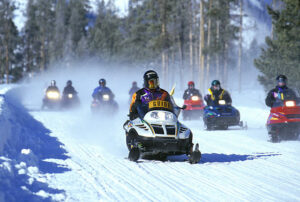
On slick surfaces like snow and ice, where wheels would often slide and slide, snowmobile tracks also offer grip. Because of the enormous surface area and abrasiveness of the grooves, the sled has a superior hold on the surface. The majority of snowmobiles have pointed studs affixed to their tracks. These studs operate like the soles of sneakers and dig briefly into hard ice or snow, creating tiny holes that enable the track to hold the ice even more securely on exceptionally treacherous terrain.
More interesting features of snowmobiles
Skateboards, motors, rails, and a few brakes sound simple enough to make together a sleigh. But there’s a lot more activity going on behind the scenes. The 500 snowmobile-related patents that the leading manufacturer in the sector, Bombardier, has filed since 1944, include a wide range of characteristics. For instance, the tracks would probably clog if you were running in wet or heavy snow, adding significantly to the weight of the drivetrain and slowing you down. Bombardier developed a snow-repelling system in the 1960s with wheels that had spiral grooves that would cut through falling snow as the track passed them in order to fight this.
When not in use, certain snowmobiles’ retractable headlights may be flipped out of the way. Again, it appears straightforward, but someone at Bombardier had to take the time to create a dependable retractable headlamp assembly in order for it to function. However, it’s interesting to look through their other improvements, which range from quick-release passenger seats and engine turbochargers to more commonplace things like electronic engine oil! As you might expect, the majority of Bombardier’s patents relate to track/tire mechanics, suspension, skis, and basic frame construction—essential snowmobile features.
Environmental concerns
Modern highways and roads are frequently surrounded by fences and barriers to protect wildlife from vehicles and vice versa. However, snowmobiles, which are built to handle various terrains, may frequently go where other vehicles cannot. Concerns have been made about this, which the snowmobile industry and environmental organizations need to address.
A major worry is engine pollution. Sled engines emit exhaust gases into the air that are harmful to automobiles. The effect of smoke emissions on the environment has been researched as the hobby has gained popularity since snowmobiles frequently pass through parkland or wilderness regions that are not frequently used by motor vehicles.
